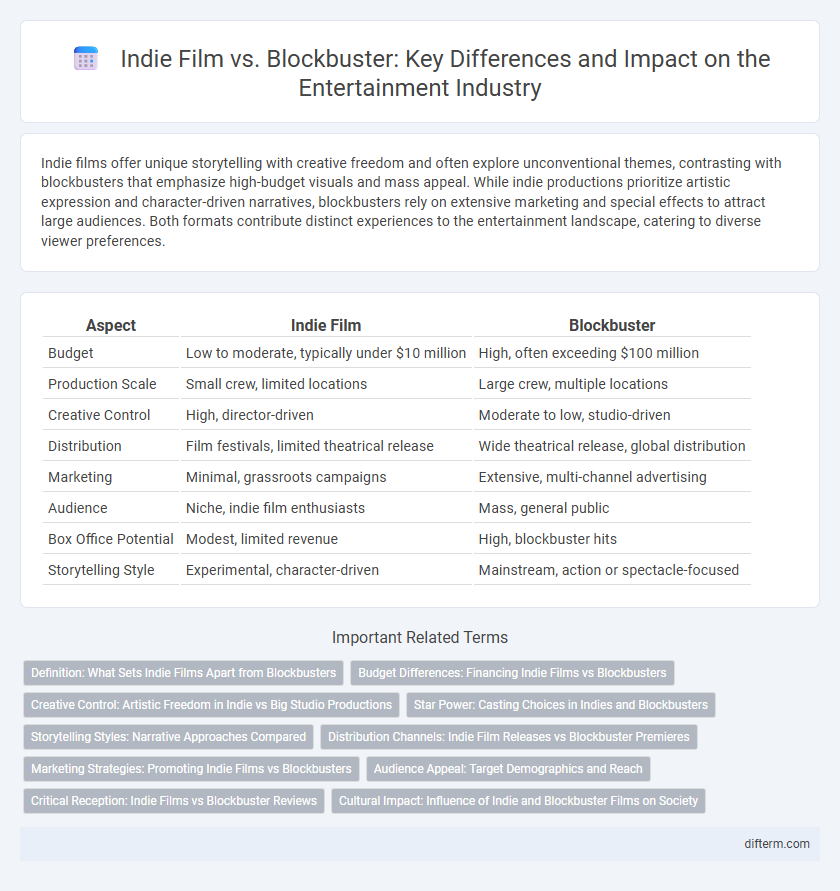Indie films offer unique storytelling with creative freedom and often explore unconventional themes, contrasting with blockbusters that emphasize high-budget visuals and mass appeal. While indie productions prioritize artistic expression and character-driven narratives, blockbusters rely on extensive marketing and special effects to attract large audiences. Both formats contribute distinct experiences to the entertainment landscape, catering to diverse viewer preferences.
Table of Comparison
| Aspect | Indie Film | Blockbuster |
|---|---|---|
| Budget | Low to moderate, typically under $10 million | High, often exceeding $100 million |
| Production Scale | Small crew, limited locations | Large crew, multiple locations |
| Creative Control | High, director-driven | Moderate to low, studio-driven |
| Distribution | Film festivals, limited theatrical release | Wide theatrical release, global distribution |
| Marketing | Minimal, grassroots campaigns | Extensive, multi-channel advertising |
| Audience | Niche, indie film enthusiasts | Mass, general public |
| Box Office Potential | Modest, limited revenue | High, blockbuster hits |
| Storytelling Style | Experimental, character-driven | Mainstream, action or spectacle-focused |
Definition: What Sets Indie Films Apart from Blockbusters
Indie films are defined by their smaller budgets, creative freedom, and focus on niche or experimental storytelling, often produced outside major studio systems. Blockbusters are large-scale productions characterized by high budgets, extensive marketing, and wide theatrical releases aimed at mass audiences. The fundamental difference lies in indie films prioritizing artistic expression and innovation, while blockbusters emphasize commercial success and broad appeal.
Budget Differences: Financing Indie Films vs Blockbusters
Indie films typically operate on modest budgets ranging from $100,000 to $5 million, relying heavily on private investors, crowdfunding, and grants for financing. Blockbusters often exceed $100 million in production costs, funded by major studios with extensive marketing and distribution resources. The budget disparity influences creative control, production scale, and risk tolerance across the two film categories.
Creative Control: Artistic Freedom in Indie vs Big Studio Productions
Indie films often provide directors and writers with greater creative control, allowing for unique storytelling and experimental techniques that reflect personal artistic visions. Big studio productions, constrained by commercial goals and studio mandates, typically prioritize mass appeal and adherence to established formulas, limiting artistic freedom. This difference in creative autonomy shapes the distinctive narrative styles and thematic depth found in indie films compared to blockbuster movies.
Star Power: Casting Choices in Indies and Blockbusters
Indie films often rely on emerging actors or lesser-known talent to bring authenticity and fresh perspectives to their stories, creating unique viewing experiences that contrast with blockbuster films. Blockbusters typically cast high-profile stars with significant box office draw to maximize audience reach and ensure commercial success. This strategic use of star power influences marketing, audience expectations, and overall film reception in the entertainment industry.
Storytelling Styles: Narrative Approaches Compared
Indie films often utilize experimental and intimate storytelling techniques, emphasizing character development and nuanced emotional arcs that prioritize artistic expression over mass appeal. Blockbusters typically adopt formulaic narratives with high-stakes plots, clear hero journeys, and visually driven scenes designed to captivate wide audiences and maximize box office success. The contrast highlights indie cinema's focus on thematic depth and personal vision versus blockbuster films' reliance on spectacle and crowd-pleasing storytelling conventions.
Distribution Channels: Indie Film Releases vs Blockbuster Premieres
Indie films often rely on film festivals, limited theatrical releases, and digital platforms like Vimeo or Amazon Prime for distribution, targeting niche audiences seeking unique storytelling. Blockbuster premieres dominate mainstream cinemas worldwide, leveraging extensive marketing campaigns and global release schedules to maximize audience reach and box office revenue. Streaming giants like Netflix and Disney+ are increasingly bridging both models, offering diverse content from indie darlings to high-budget productions.
Marketing Strategies: Promoting Indie Films vs Blockbusters
Indie films rely heavily on grassroots marketing strategies including film festivals, social media campaigns, and influencer partnerships to build niche audiences and generate word-of-mouth buzz. Blockbusters utilize large-scale marketing budgets to secure prime advertising spots across television, digital platforms, and outdoor media, combined with star-studded premieres and global promotional tours. Targeted data analytics enable blockbuster studios to optimize audience reach while indie filmmakers capitalize on authentic storytelling to engage dedicated fan bases.
Audience Appeal: Target Demographics and Reach
Indie films primarily attract niche audiences who seek unique storytelling and innovative cinematic techniques, often resonating with art house enthusiasts and younger, urban demographics. Blockbusters target a broad, global audience through mainstream appeal, leveraging high budgets for special effects, star power, and extensive marketing campaigns to maximize box office reach. The disparity in audience scope reflects indie films' focus on depth and creativity, contrasting with blockbusters' emphasis on wide commercial success.
Critical Reception: Indie Films vs Blockbuster Reviews
Indie films often receive critical acclaim for their originality, character depth, and artistic innovation, appealing to niche audiences and film critics who value storytelling over spectacle. Blockbusters generally attract mixed reviews, praised for high production values and visual effects but sometimes criticized for formulaic plots and lack of depth. Review aggregates like Rotten Tomatoes and Metacritic typically show higher critic scores for indie films compared to blockbuster releases.
Cultural Impact: Influence of Indie and Blockbuster Films on Society
Indie films often challenge mainstream narratives by exploring niche topics and diverse perspectives, fostering cultural dialogue and increasing representation in cinema. Blockbuster films shape popular culture through widespread reach and mass appeal, influencing fashion, language, and entertainment trends on a global scale. The contrasting cultural impacts of indie versus blockbuster films highlight the importance of both experimental storytelling and large-scale productions in shaping societal values and collective experiences.
Indie film vs Blockbuster Infographic

 difterm.com
difterm.com